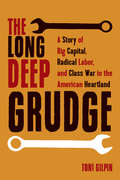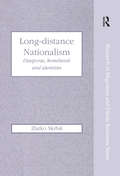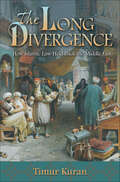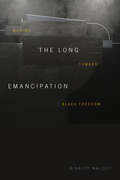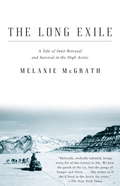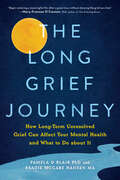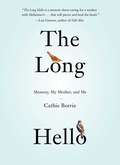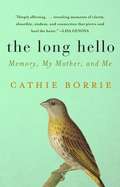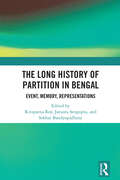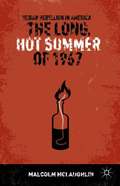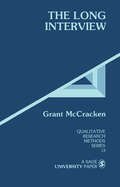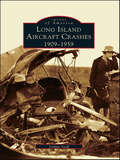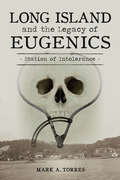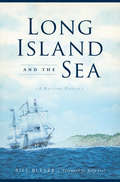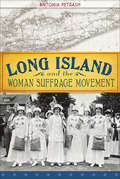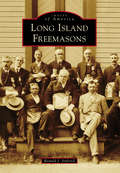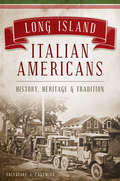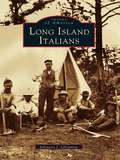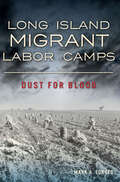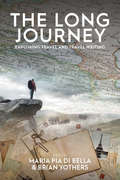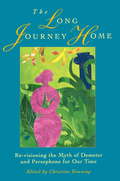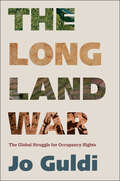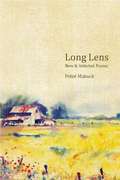- Table View
- List View
The Long Deep Grudge: A Story of Big Capital, Radical Labor, and Class War in the American Heartland
by Toni Gilpin&“The definitive history of an important but largely forgotten labor organization and its heroic struggles with an icon of industrial capitalism.&” —Ahmed A. White, author of The Last Great Strike This rich history details the bitter, deep-rooted conflict between industrial behemoth International Harvester and the uniquely radical Farm Equipment Workers union. The Long Deep Grudge makes clear that class warfare has been, and remains, integral to the American experience, providing up-close-and-personal and long-view perspectives from both sides of the battle lines. International Harvester—and the McCormick family that largely controlled it—garnered a reputation for bare-knuckled union-busting in the 1880s, but in the twentieth century also pioneered sophisticated union-avoidance techniques that have since become standard corporate practice. On the other side the militant Farm Equipment Workers union, connected to the Communist Party, mounted a vociferous challenge to the cooperative ethos that came to define the American labor movement after World War II. This evocative account, stretching back to the nineteenth century and carried through to the present, reads like a novel. Biographical sketches of McCormick family members, union officials and rank-and-file workers are woven into the narrative, along with anarchists, jazz musicians, Wall Street financiers, civil rights crusaders, and mob lawyers. It touches on pivotal moments and movements as wide-ranging as the Haymarket &“riot,&” the Flint sit-down strikes, the Memorial Day Massacre, the McCarthy-era anti-communist purges, and America&’s late twentieth-century industrial decline. &“A capitalist family dynasty, a radical union, and a revolution in how and where work gets done—Toni Gilpin&’s The Long Deep Grudge is a detailed chronicle of one of the most active battlefronts in our ever-evolving class war.&” —John Sayles
Long-Distance Nationalism: Diasporas, Homelands and Identities (Research in Migration and Ethnic Relations Series)
by Zlatko SkrbišHow strong and how significant is the interaction between migrants and homelands in the late 20th century? Have the processes of globalization and transnational interaction produced new forms of nationalism or at least altered the old ones? By using Croatians and Slovenians in Australia as examples this book examines the extent to which migrants are influenced by historical and contemporary processes of migration mediated through political and cultural symbolism. What are the factors which influence the existence, nature and intensity of ethno-nationalism in the migrant context? The study analyses both the existence and transmission of ethno-nationalism between migrant settings and homelands and specifically deals with the transmission of ethno-nationalism sentiments across migrant generations. To understand the effects and consequences of long-distance nationalism fully the book proceeds from an analysis of nationalism’s public manifestations to an analysis of the relatively private domain of diasporic ethno-communal existence.
The Long Divergence: How Islamic Law Held Back the Middle East
by Timur KuranHow religious barriers stalled capitalism in the Middle EastIn the year 1000, the economy of the Middle East was at least as advanced as that of Europe. But by 1800, the region had fallen dramatically behind—in living standards, technology, and economic institutions. In short, the Middle East had failed to modernize economically as the West surged ahead. What caused this long divergence? And why does the Middle East remain drastically underdeveloped compared to the West? In The Long Divergence, one of the world's leading experts on Islamic economic institutions and the economy of the Middle East provides a new answer to these long-debated questions.Timur Kuran argues that what slowed the economic development of the Middle East was not colonialism or geography, still less Muslim attitudes or some incompatibility between Islam and capitalism. Rather, starting around the tenth century, Islamic legal institutions, which had benefitted the Middle Eastern economy in the early centuries of Islam, began to act as a drag on development by slowing or blocking the emergence of central features of modern economic life—including private capital accumulation, corporations, large-scale production, and impersonal exchange. By the nineteenth century, modern economic institutions began to be transplanted to the Middle East, but its economy has not caught up. And there is no quick fix today. Low trust, rampant corruption, and weak civil societies—all characteristic of the region's economies today and all legacies of its economic history—will take generations to overcome.The Long Divergence opens up a frank and honest debate on a crucial issue that even some of the most ardent secularists in the Muslim world have hesitated to discuss.
The Long Emancipation: Moving toward Black Freedom
by Rinaldo WalcottIn The Long Emancipation Rinaldo Walcott posits that Black people globally live in the time of emancipation and that emancipation is definitely not freedom. Taking examples from across the globe, he argues that wherever Black people have been emancipated from slavery and colonization, a potential freedom has been thwarted. Walcott names this condition the long emancipation—the ongoing interdiction of potential Black freedom and the continuation of the juridical and legislative status of Black nonbeing. Stating that Black people have yet to experience freedom, Walcott shows that being Black in the world is to exist in the time of emancipation in which Black people must constantly fashion alternate conceptions of freedom and reality through expressive culture. Given that Black unfreedom lies at the center of the making of the modern world, the attainment of freedom for Black people, Walcott contends, will transform the human experience worldwide. With The Long Emancipation, Walcott offers a new humanism that begins by acknowledging that present conceptions of what it means to be human do not currently include Black people.
The Long Exile: A Tale of Inuit Betrayal and Survival in the High Arctic
by Melanie McgrathArriving in the Inuit community of Inukjuak, on the east coast of the Hudson Bay, in 1920, Robert Flaherty set about filming his influential film Nanook of the North. After finishing his filming, Flaherty would leave never to return, but the son he fathered, Josephie Flaherty, would remain behind to suffer with his community as they were forcibly moved hundreds of miles north by the Canadian government some 30 years later, not to receive any form of redress until the mid-1990s. This book both describes the making of the movie and the influence it had on perceptions of the Inuit and the fortunes of Robert Flaherty's Inuit descendants as they coped with exile and hardship. Annotation ©2007 Book News, Inc. , Portland, OR (booknews. com)
The Long Exile
by Melanie McgrathIn 1952, the Canadian government forcibly relocated three dozen Inuit from their flourishing home on the Hudson Bay to the barren, arctic landscape of Ellesmere Island, the most northerly landmass on the planet. Among this group was Josephie Flaherty, the unrecognized, half-Inuit son of filmmaker Robert Flaherty, director of Nanook of the North. In a narrative rich with human drama, Melanie McGrath follows three generations of the Flaherty family--Robert, Josephie, and Josephie's daughters--to bring this extraordinary tale of deception and harsh deprivation to life.From the Trade Paperback edition.
The Long Grief Journey: How Long-Term Unresolved Grief Can Affect Your Mental Health and What to Do About It
by Pamela Blair PhD Bradie McCabe Hansen MAAn essential grief guide and recovery workbook for those who have said, "I thought I'd feel better by now."Grief does not follow a timeline or a set path. It is nonlinear and messy, doubling back on itself just when you thought you were out of the woods. Those who have experienced the loss of a loved one know this unequivocally, but Western society still seems to think that grief should only last six months to a year—tops—when in fact, grief can last throughout a person's entire life and manifest as serious mental health issues, including depression, anxiety, anger, and despair.The Long Grief Journey, co-written by a psychotherapist and a clinical psychologist who have both worked with grieving individuals for decades, is for the people who are past the acute pain and effects of a sudden loss and are now learning to live beyond that. It is for those who by all appearances seem to have "moved on." They're working, carrying out their responsibilities, showing up for important life events, yet they quietly bear the weight of their sadness and longing for their loved one. There's a name for this type of long-term, unresolved grief. In fact, there are several: complicated grief, traumatic grief, complex bereavement, prolonged grief, extended grief, abnormal grief, exaggerated grief, and pervasive grief disorder. If you feel "stuck" after experiencing the death of a loved one, even if much time has passed, this book is for you.With exercises, journal prompts, and rituals that will further help readers along their grief path, The Long Grief Journey, co-written by one of the authors of the classic grief book, I Wasn't Ready to Say Goodbye, is designed to educate, support, and coach you to rekindle a desire to live life fully, all while still cherishing and embracing the memories of your loved one.Named one of Choosing Therapy's "14 Best Books on Losing a Parent for 2022."
The Long Hello
by Cathie BorrieA stirring memoir of a daughter caring for a mother with dementia that is sure to become a touchstone for many others.The Long Hello explores the emotional rewards and challenges that Cathie Borrie experienced in caring for her mother, who was living with Alzheimer's disease, for seven years. Between the two, a wondrously poetic dialogue develops, which Ms. Borrie further illuminates with childhood memories of her family, and her struggle to maintain a life outside her caregiving responsibilities. The Long Hello demonstrates how caregiving creates an opportunity to experience the change in a relationship that illness necessitates, one in which joy, meaning, and profound intimacy can flourish.Written in spare, beautiful prose, largely in the form of a dialogue, The Long Hello exquisitely captures the intricacies and nuances of a daughter's relationship with her mother.
The Long Hello: Memory, My Mother, and Me (The\long Hello Ser.)
by Cathie BorrieThe moving memoir of caring for a parent with Alzheimer’s that broke new ground, changed the narrative, and prompted Maya Angelou to exclaim, “Joy!” Since Cathie Borrie delivered her keynote performance at the World Alzheimer’s Day event, her self-published manuscript has won rapturous praise from noted writers and Alzheimer’s experts alike—from Maya Angelou, Lisa Genova, and Molly Peacock to Dr. Bill Thomas, Jed A. Levine of the Alzheimer’s Association, NYC, and Meryl Comer of the Geoffrey Beene Foundation Alzheimer’s Initiative. The Long Hello distills the seven years the author spent caring for her mother into a page-turning account that offers insight into the “altering world of the dementia mind.” During that time, Borrie recorded brief conversations she had with her mother that revealed the transformations within—and sometimes yielded an almost Zen-like poetry. She includes selections from them in chapters about her experience that are as evocative as diary entries. Her mother was the emotional pillar and sometime breadwinner in a home touched by a birth father’s alcoholism, a brother’s early death, divorce, and a stepfather’s remoteness. In Borrie’s spare prose, her mother’s story becomes a family’s story as well a deeply loving portrait that embraces life.
The Long History of Partition in Bengal: Event, Memory, Representations
by Rituparna Roy Jayanta Sengupta Sekhar BandyopadhyayThis book focuses on the aftermath of the 1947 Partition of India. It considers the long aftermath and afterlives of Partition afresh, from a wide and inclusive range of perspectives and studies the specificities of the history of violence and migration and their memories in the Bengal region. The chapters in the volume range from the administrative consequences of partition to public policies on refugee settlement, life stories of refugees in camps and colonies, and literary and celluloid representations of Partition. It also probes questions of memory, identity, and the memorialization of events. Eclectic in its theoretical orientation and methodology, this book will be of interest to scholars and researchers of partition history, colonialism, refugee studies, Indian history, South Asian history, migration studies, and modern history in general.
The Long, Hot Summer Of 1967
by Malcolm MclaughlinIt seemed at times during the 1960s that America was caught in an unending cycle of violence and disorder. Successive summers from 1964-1968 brought waves of urban unrest, street fighting, looting, and arson to black communities in cities from Florida to Wisconsin, Maryland to California. In some infamous cases like Watts (1965), Newark (1967), and Detroit (1967), the turmoil lasted for days on end and left devastation in its wake: entire city blocks were reduced to burnt-out ruins and scores of people were killed or injured mainly by police officers and National Guardsmen as they battled to regain control. This book takes the pivotal year of 1967 as its focus and sets it in the context of the long, hot summers to provide new insights into the meaning of the riots and their legacy. It offers important new findings based on extensive original archival research, including never-before-seen, formerly embargoed and classified government documents and newly released official audio recordings.
The Long Interview
by Dr Grant MccrackenThe Long Interview provides a systematic guide to the theory and methods of the long qualitative interview or intensive interviewing. It gives a clear explanation of one of the most powerful tools of the qualitative researcher. The volume begins with a general overview of the character and purpose of qualitative inquiry and a review of key issues. The author outlines the four steps of the long qualitative interview and how to judge quality. He then offers practical advice for those who commission and administer this research, including sample questionnaires and budgets to help readers design their own. The author introduces key theoretical and methodological issues, various research strategies, and a simple four-stage model of inquiry, from the design of an open-ended questionnaire to the write up of results.
Long Island Aircraft Crashes: 1909-1959
by Joshua StoffDuring the first fifty years of American aviation, Long Island was at the center of aircraft innovation and flight. There were more aircraft manufacturers and airports located on Long Island than in any other part of the United States. Due to the extraordinarily high volume of air traffic, Long Island also led the country-if not the world-in aircraft crashes. Long Island Aircraft Crashes: 1909-1959 portrays the daring flights, accidents, and mishaps of pioneer pilots, and the conditions that contributed to many crashes. Long Island ultimately saw the earliest air-traffic control systems, airport lighting, aviation weather reports, paved runways, and professional flight schools. Long Island Aircraft Crashes: 1909-1959 contains captivating images from Mitchel Field and Roosevelt Field, the two most active airfields on Long Island. In addition to airfield activity, this book illustrates some of the first experimental flights over Hempstead Plains; military training at Hazelhurst Field; the L.W.F. Owl bomber (the largest landplane of its time); the world's first instrument-guided flight; and Amelia Earhart posing with the new Sperry Gyropilot.
Long Island and the Legacy of Eugenics: Station of Intolerance
by Mark A. TorresA Dark History Revealed In the early twentieth century, eugenics was at the forefront of scientific discourse in the quest to understand human genetics. On Long Island and throughout the nation, eugenicists were granted unfettered access to conduct experiments on prisoners, psychiatric patients, Coney Island circus performers and more, all in an effort to legitimize a false science. The origins of the eugenics movement can be found within the Eugenics Record Office, an otherwise nondescript two-and-a-half-story administrative building at Cold Spring Harbor, New York, under the direction of Charles Benedict Davenport from 1910 to 1939. The work conducted there directly led to the forced sterilization of thousands of American citizens and the passage of anti-immigration laws and sparked a deadly global movement. Author Mark Torres explores the local characters, influences, landmarks and ghastly consequences that emanated from this small Long Island facility for decades and spread throughout the world.
Long Island and the Sea: A Maritime History
by Bill BleyerFor more than five centuries, the waterways surrounding Long Island have profoundly shaped its history. Familiar subjects of lighthouses, shipwrecks and whaling are found alongside oft-forgotten history such as Pan-American flying boats landing in Manhasset Bay in the early days of transatlantic flight. From the British blockade and skirmishes during the American Revolution to the sinking of merchant vessels by Germany in World War II, the sea brought wars to these shores. Gold Coast millionaires commuted in high-speed yachts to Manhattan offices as the island's wealth grew. Historian Bill Bleyer reveals Long Island's nautical bonds from the Native Americans to current efforts to preserve the region's maritime heritage.
Long Island and the Woman Suffrage Movement
by Antonia PetrashAn account of how the women’s rights movement found fertile ground on Long Island and succeeded thanks to the suffragettes’ classic grassroots campaign. For seventy-two years, American women fought for the right to vote, and many remarkable ladies on Long Island worked tirelessly during this important civil rights movement. The colorful—and exceedingly wealthy—Alva Vanderbilt Belmont was undoubtedly the island’s most outspoken and controversial advocate for woman suffrage. Ida Bunce Sammis, vigorous in her efforts, became one of the first women elected to the New York legislature. Well-known Harriot Stanton Blatch, daughter of Elizabeth Cady Stanton, worked with countless other famous and ordinary Long Islanders to make her mother’s quest a reality. Author Antonia Petrash tells the story of these and other women’s struggle to secure the right to vote for themselves, their daughters and future generations of Long Island women.
Long Island Freemasons (Images of America)
by Ron SeifriedThe first Masonic lodge in what is today Nassau and Suffolk Counties was constituted in 1793. For over 200 years, more than 70 lodges were founded and flourished in various locations from Amagansett to Great Neck. For the first time, some of the secrets of the Masonic fraternity are revealed in this book. Recovered from dusty lodge attics and closets, this selection of long-forgotten photographs and artifacts gives the readers a brief glimpse of what was taking place behind the closed doors of their local lodge. Long Island was the Masonic home of Theodore Roosevelt of Oyster Bay and, 30 years later, was honored by a visit to the Huntington Masonic lodge by his fifth cousin and fellow Mason Franklin D. Roosevelt. Masons continue to support the community through charitable endeavors, including the Masonic Medical Research Institute, Masonic Safety Identification Programs, Shriners Hospitals, and many more.
Long Island Italian Americans: History, Heritage and Tradition (American Heritage)
by Salvatore J. LaguminaFor Italian immigrants and their descendants, moving from "the city" out to Long Island was more than a change of address. It signaled that the family had achieved the American dream, and in turn, elements of Italian values and culture are visible all over the island. Italians helped to build Long Island, whether as laborers or as contractors, such as the Castagnas. They brought their culinary traditions and opened markets, such as the still family-owned Iavarone Brothers Foods and restaurants, including New Hyde Park's Umberto's. Italians' industrialism helped them thrive in fields as diverse as medicine, politics, acting and winemaking and importing (including the nationally recognized Banfi label). Join author Salvatore J. LaGumina to discover the remarkable contributions and vibrant culture of Italians and Italian-Americans on Long Island.
Long Island Italians (Images of America)
by Salvatore J. LaguminaIn America "the streets were paved with gold." That was the mistaken notion of many an immigrant to the United States in the late 1800s and early 1900s. On Long Island, deluded sojourners from Italy were to find that in fact there were few streets and that they themselves were to be the ones to build them.Covering more than a century of history, Long Island Italians depicts the transition of urban Italians as they moved increasingly from the city to the suburbs in Nassau and Suffolk Counties. They were attracted to Long Island by economic opportunity, the availability of arable land, home ownership possibilities, and alternatives to harsh city life. There, they became the largest of all ethnic groups, with more Americans of Italian descent living in one concentrated area than anywhere besides Italy. The Italian American presence is a continuing phenomenon, today comprising about 25 percent of the total population of Long Island. Long Island Italians graphically illustrates that Italian laborwas vital to the development of Long Island roads, agriculture, railroads, and industry. By the early twentieth century, Italians made up the bulk of the work force. The book goes beyond the laborers to show also the warmth of Italian family life, the strength of the social organizations, and the rise of the politicians.
Long Island Migrant Labor Camps: Dust for Blood
by Mark A TorresThe little-known history of the Suffolk County camps where migrant workers lived in squalor during and after WWII—includes photos. During World War II, a group of potato farmers opened the first migrant labor camp in Suffolk County to house farmworkers from Jamaica. Over the next twenty years, more than one hundred camps of various sizes would be built throughout the region. Thousands of migrant workers lured by promises of good wages and decent housing flocked to Eastern Long Island, where they were often cheated out of pay and housed in deadly slum-like conditions. Preyed on by corrupt camp operators and entrapped in a feudal system that left them mired in debt, laborers, whether Jamaican or Mexican, Polish or Chinese, struggled and, in some cases, perished in the shadow of New York&’s affluence. In this book Mark A. Torres reveals the dreadful history of Long Island&’s migrant labor camps from their inception to their peak in 1960—and their steady decline in the following decades. &“I urge folks to read this book.&” —Fire Island News
The Long Journey: Exploring Travel and Travel Writing
by Maria Pia Di Bella and Brian YothersTravel writing has, for centuries, composed an essential historical record and wide-ranging literary form, reflecting the rich diversity of travel as a social and cultural practice, metaphorical process, and driver of globalization. This interdisciplinary volume brings together anthropologists, literary scholars, social historians, and other scholars to illuminate travel writing in all its forms. With studies ranging from colonial adventurism to the legacies of the Holocaust, The Long Journey offers a unique dual focus on experience and genre as it applies to three key realms: memory and trauma, confrontations with the Other, and the cultivation of cultural perspective.
The Long Journey Home: Revisioning the Myth of Demeter and Persephone for Our Time
by Christine DowningThe story of the mother-and-daughter goddesses Demeter and Persephone has seized the imagination of people in every age, from ancient times to the present. Considered today by many to be the archetypal myth for women, it touches on timeless themes in every life, such as the male-female relationship, love between women, initiations into puberty and old age, the mother-daughter bond, death, and ecological renewal. Christine Downing has combined essays, prose, poetry, and even performance art with her own insightful commentary to shed new light on the myth's ancient meanings and to offer new insights in its implications for contemporary men and women.
The Long Journeys Home: The Repatriations of Henry ‘Opukaha‘ia and Albert Afraid of Hawk (The Driftless Connecticut Series)
by Nick BellantoniHenry ‘Opukaha‘ia (ca. 1792–1818), Native Hawaiian, and Itankusun Wanbli (ca. 1879–1900), Oglala Lakota, lived almost a century apart. Yet the cultural circumstances that led them to leave their homelands and eventually die in Connecticut have striking similarities. <P>‘Opukaha‘ia was orphaned during the turmoil caused in part by Kamehameha’s wars in Hawai’i and found passage on a ship to New England, where he was introduced and converted to Christianity, becoming the inspiration behind the first Christian missions to Hawai’i. Itankusun Wanbli, Christianized as Albert Afraid of Hawk, performed in Buffalo Bill’s “Wild West” as a way to make a living after his traditional means of sustenance were impacted by American expansionism. <P><P>Both young men died while on their “journeys” to find fulfillment and both were buried in Connecticut cemeteries. In 1992 and 2008, descendant women had callings that their ancestors “wanted to come home” and began the repatriation process of their physical remains. <P><P>CT state archaeologist Nick Bellantoni oversaw the archaeological disinterment, forensic identifications and return of their skeletal remains back to their Native communities and families. The Long Journeys Home chronicles these important stories as examples of the wide-reaching impact of American imperialism and colonialism on Indigenous Hawaiian and Lakota traditions and their cultural resurgences, in which the repatriation of these young men have played significant roles. <P><P>Bellantoni’s excavations, his interaction with two Native families and his participation in their repatriations have given him unique insights into the importance of heritage and family among contemporary Native communities and their common ground with archaeologists. His natural storytelling abilities allow him to share these meaningful stories with a larger general audience.
The Long Land War: The Global Struggle for Occupancy Rights (Yale Agrarian Studies Series)
by Jo GuldiA definitive history of ideas about land redistribution, allied political movements, and their varied consequences around the world &“An epic work of breathtaking scope and moral power, The Long Land War offers the definitive account of the rise and fall of land rights around the world over the last 150 years.&” —Matthew Desmond, Pulitzer Prize–winning author of Evicted: Poverty and Profit in the American City Jo Guldi tells the story of a global struggle to bring food, water, and shelter to all. Land is shown to be a central motor of politics in the twentieth century: the basis of movements for giving reparations to formerly colonized people, protests to limit the rent paid by urban tenants, intellectual battles among development analysts, and the capture of land by squatters taking matters into their own hands. The book describes the results of state-engineered &“land reform&” policies beginning in Ireland in 1881 until U.S.-led interests and the World Bank effectively killed them off in 1974. The Long Land War provides a definitive narrative of land redistribution alongside an unflinching critique of its failures, set against the background of the rise and fall of nationalism, communism, internationalism, information technology, and free-market economics. In considering how we could make the earth livable for all, she works out the important relationship between property ownership and justice on a changing planet.
Long Lens: New and Selected Poems (American Poets Continuum)
by Peter Makuck"Peter Makuck sees through the detritus of daily life to what matters. . . . It’s that essence that lives deep down in things, looked for in people, sea- and landscapes, and creatures, that lifts the quotidian toward the marvelous, and animates this selection of poems from four decades."—Brendan GalvinFrom "Long Lens":Folding laundry, I can see our clotheslinewaving its patches of color like the flagof a foreign country where I had happily livedin a small clapboard house surrounded by pines.I can hear my mother in her strong accentsaying she didn’t want a dryereven when we could finally afford one—Our sheets won’t smell of trees and sunlight anymore.Long Lens represents forty years of Peter Makuck’s work, including twenty-five new poems. With precise language, Makuck’s imagery evokes spiritual longing, love, loss, violence, and transcendence. His subjects include the aftermath of the 1970 killings at Kent State University; scuba diving on an offshore shipwreck; flying through a storm in a small plane; rescuing a boy caught in a riptide; and lucid observations of spinner sharks, a gray fox, a spider, and a pelican tangled in a fishing line.Peter Makuck taught at East Carolina University from 1976 to 2006, where he founded Tar River Poetry. He was 2008 Lee Smith Chair in Creative Writing at North Carolina State University. Winner of the Brockman Award and the Charity Randall Citation, he lives on Bogue Banks, one of North Carolina’s barrier islands.
